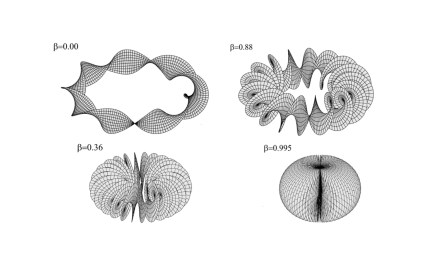For over a century, the speed of light has been considered the ultimate limit in the universe, shaping our understanding of space, time and relativity. Now, a groundbreaking idea proposes the existence of another universal speed limit: an invariant minimum speed embedded in the fabric of space and time. This discovery of an absolute minimum speed at the quantum level reshapes the long-standing belief in absolute rest within the Newtonian scenario and reveals a surprising link between the smallest quantum particles and the vast reaches of the cosmos. By introducing this minimum speed into a new theoretical framework, scientists aim to unravel mysteries about the universe, from the behavior of hydrogen atom to the force that accelerates the expansion of the cosmos.
Dr. Cláudio Nassif Cruz from the Federal University of Ouro Preto has developed a fascinating framework in physics that proposes this minimum speed as a new fundamental constant of nature. Known as Symmetrical Special Relativity (SSR), this is a new theory of motion that builds on Einstein’s work by adding an additional speed limit given at lower energy scales associated with a gravitational vacuum working like an aether. This innovative concept of SSR proposed originally by Cruz has been published in Physics of the Dark Universe. Dr. Cruz aims to reshape our understanding of both the quantum world and the universe on a grand scale by including the dark energy as a new aether related to a background frame for the invariant minimum speed.
In this new theory of space-time, two universal speed limits are described : the speed of light and an unattainable minimum speed, so slow that no particle can never reach it. This minimum speed is not merely theoretical; it has real implications. It connects to a special reference frame in space, a fundamental framework that provides a universal baseline for motion, associated with the vacuum energy that fills the universe playing the role of a new aether. Vacuum energy refers to the underlying energy present even in empty space. The hydrogen atom plays a key role in this theory as it represents the lightest and most stable structure. Its characteristics help scientists understand how this minimum speed links the smallest particles to cosmic-scale phenomena. The calculations based on the ratio of the electric and gravitational force in hydrogen atom lead to the emergence of this minimum speed. It can explain fundamental properties of matter, such as the ratio of proton mass to electron mass, and how it influences the energy levels within atoms.
One of the most exciting outcomes of Dr. Cruz’s research is a new explanation for the energy levels of hydrogen atoms, which are shaped by this minimum speed. These findings also provide fresh insights into the cosmological constant, which is the factor that explains why the universe’s expansion is accelerating. Dr. Cruz suggests that his theory can naturally explain this constant as part of a unified framework. He believes that SSR offers an entirely new way to understand the connection between quantum physics, which governs the behavior of tiny particles, and gravity, which shapes the universe on the largest scales. “The concept of a minimum speed not only changes how we think about classical physics but also reveals unexpected links between quantum uncertainty, the principle that limits how precisely certain properties of particles can be known, and a quantum gravity,” Dr. Cruz remarked.
Dr. Cruz also proposed an exciting way to test this theory experimentally. His colleague is already establishing contact with an experimental group in Virginia (USA) to carry out the experiment, where the use of ultra-cold systems is suggested. Such systems are known as Bose–Einstein condensates (BEC), unique states of matter created when particles are cooled to near absolute zero. These systems could exhibit unusual effects predicted by the theory, providing potential evidence for the existence of the minimum speed. One of the most fascinating predictions involves how this minimum speed could affect time itself. As Dr. Cruz explained, “An experiment at ultra-low temperatures could test a new deformation in time due to the minimum speed. When temperatures approach absolute zero or the speed of particles nears the minimum speed, it would lead to a contraction in the half-life time of a hypothetical ultra-cooled atomic clock measured in the laboratory at room temperature, i.e., an improper time contraction. This is in stark contrast to what happens when an atomic clock is close to the speed of light, which causes the dilation of its half-life time in the laboratory, or the so-called improper time dilation. If the time contraction close to the absolute zero or minimum speed is confirmed in the laboratory, this would revolutionize our understanding of space-time and gravity, initiating a paradigm shift in physics that began with Einstein in the 20th century. It would herald a new era in 21st-century physics and cosmology by explaining the origins of the cosmological constant and vacuum energy within a unified theory.”
This study pushes the boundaries of traditional physics, positioning SSR as a transformative step toward unifying the fragmented areas of quantum mechanics, the study of the behavior of particles at the smallest scales, and cosmology, the science of the universe as a whole. By redefining space and time with two universal speed limits, this groundbreaking research could open the door to a deeper understanding of our universe, from the simplest hydrogen atoms to the mysteries of dark energy that govern cosmic expansion.
Journal Reference
C.N. Cruz and A.C. Amaro de Faria Jr., “The cosmological constant and energy quantization in hydrogen atom in light of a doubly special relativity with a minimum speed,” Physics of the Dark Universe, 2024. DOI: https://doi.org/10.1016/j.dark.2024.101700
About the Author

Cláudio Nassif Cruz is retired Professor of Physics, Federal University of Ouro Preto (UFOP) , Ouro Preto, Minas Gerais, Brazil. He was born in Além Paraíba, Minas Gerais, in August 1967.
He got his bachelor’s degree of Physics (1992) in Federal University of Juiz de Fora (UFJF), Minas Gerais, Brazil.
His master’s degree (1992) and Ph.D degree (2002) of Physics was in Federal University of Minas Gerais (UFMG), Belo Horizonte, Minas Gerais, Brazil.
He has long experience in the area of Condensed Matter Physics, with emphasis on State Equation, Phase Equilibrium and Phase Transitions, focusing on the following topics as a line of work, namely Thompsons approach, Renormalization Group, dynamical and stationary critical exponents for various systems, diffusion-limited chemical reactions, polymers, surface growth, N-vector model without random field. Also some topics in field theories, such as Quantum Electrodynamics (QED) and Quantum Chromodynamics (QCD) are treated on Thompsons approach.
In another line of original research that he himself introduced, he works on the exploration of another possibility of Lorentz symmetry breaking for a Deformed Special Relativity with an invariant minimum speed (Symmetrical Special Relativity), where a background field is generated by a non-Lorentzian dynamics at low energies, thus explaining the tiny positive value of the cosmological constant and also explaining the principle of quantum uncertainty, allowing us to make a connection between quantum physics and cosmology.













































